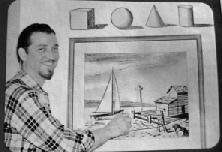 |

Infomercial watch
No infomercials allowed
 |
Did You "Learn to Draw" With Jon Gnagy?
Television pioneer convinced a generation of viewers that anyone could be an artist
By Bill Einhorn, Fairfield, Connecticut
If you watched television during the 1940s, '50s or '60s, you likely recall Jon Gnagy, the engaging art teacher who assured folks that anyone could draw. "Ball....cube.....cylinder....cone," Jon would say at the beginning of his 15-minute program, Learn to Draw. "By using these four shapes, I can draw any picture I want. And so can you!"
Sincerity and quiet confidence flowed from Jon, reflecting a humble Mennonite upbringing in Pretty Prairie, Kansas. His trim Vandyke beard, smile and plaid shirt were his trademarks.
I produced Jon's TV show from 1950 to '55. Later, through syndication, it was viewed by millions of folks across the U.S. and Canada well into the 1960s. While many remember this selftaught artist's Saturday-morning TV show, they may not recall that he was a television star before Lucille Ball, Milton Berle or Arthur Godfrey. In fact, Jon was the first act on the first commercial television show ever, broadcast May 14,1946. On that day, NBC's Studio H in New York City was filled with excited anticipation. The tiny studio, up until then used for radio, was ablaze with whitehot lights and jammed with technicians.
Live TV Was "Hot"
Sweltering in the 130 degree heat, Master of Ceremonies Warren Hull rehearsed the introductions for the first broadcast of Radio City Matinee, reading his lines from a crudely printed card known as an "idiot board". The floor manager cued Hull with a countdown:" five....four....three....two....one.....here we go!"
"Welcome to Radio City Matinee!" Hull enthused, running through his intros. The show would include Maggie McNellis, Virginia Sales, comedian Eddie Mayhoff, and famous chef George Rector hosting TV's first cooking show. But the opening attraction was television's very first art teacher. "And here he is, " Hull said, "Jon Gnagy."
Jon's usually controlled and confident voice cracked a bit as he looked into the camera and said, "Hello, friends this is Jon Gnagy to prove to you that you can learn to draw by following my step-by-step lessons. Today we're going to draw this picture of an old oak tree...." Reaching for a crayon to make his first stroke, Jon found it had melted into a shapeless mass from the heat! Calmly he substituted a piece of chalk.
As he drew his first line, the chalk let out a squeak. Every line Jon drew was accompanied by another squeak....but he proceeded confidently, explaining each step, until the drawing was nearly complete. After 7 minutes, the floor manager waved the "cut" sign. Jon quickly finished the drawing with silhouettes of birds on the tree branches. When the camera switched back to Warren Hull, Jon moved away from the hot lights, sopping wet and drained by his first performance. Almost instantly, NBC founder David Sarnoff phoned to congratulate him. Dr Vladimir Zworykin, inventor of the TV camera and picture tube, gave Jon a hearty handshake. But the best compliment came from the floor manager who coined a phrase when he said, "Jon, your show is pure television!"
From Hundreds to Millions
That first live program was seen by about 200 viewers living within 80 miles of NBC's 61-ft tower atop the Empire State Building. Later, Jon's show would reach millions.Interestingly, Jon was never paid for any of his telecasts. Instead, he earned a royalty from the art sets he promoted. Over 15 million of them have been sold, and those sets still help folks learn to draw today. Jon Gnagy didn't appear on television for money or fame. he did it because he sincerely felt he had a message that would help people. And this quiet Midwesterner was one of the first to recognize TV's power to reach people.
Today, Jon's legacy lives on in countless artists who learned from him.
Live TV Was "Hot"
From Hundreds to Millions

